Beyond Housing Development in Pagedale Ignores Pedestrians, ADA
In August 2010 a new Save-A-Lot grocery store opened in the St. Louis County municipality of Pagedale:
ST. LOUIS, August 5, 2010 – Save-A-Lot, a SUPERVALU (NYSE: SVU) company, one of the nation’s leading hard discount carefully selected assortment grocery chains, has extended its commitment to a local neighborhood in need of access to fresh produce, dairy and meats with the opening of the first new grocery retailer in the Pagedale community in 40 years. The store is a result of a partnership with Beyond Housing, one of the St. Louis region’s leading providers of housing and support services for low-income families and homeowners.
“We are thrilled to celebrate the opening of this new Save-A-Lot Food Store, which will serve thousands of families including hundreds in the Pagedale community,” says Chris Krehmeyer, president and CEO of Beyond Housing. “The opening of this store is another step toward our goal of providing families with access to necessities, such as groceries and bringing new jobs to the community.” (Save-A-Lot)
Pagedale is a low-income municipality that has long been ignored by for-profit developers.
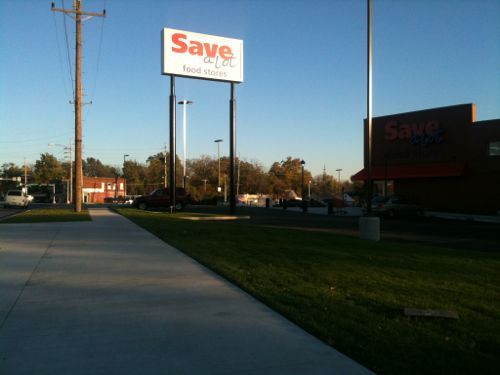
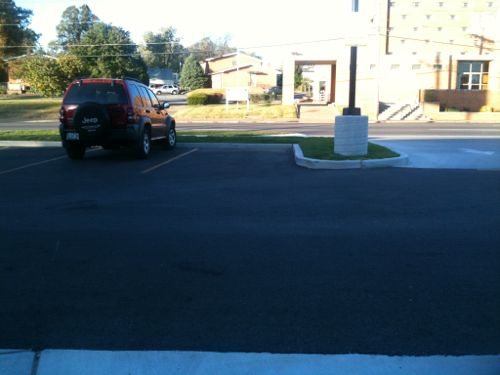
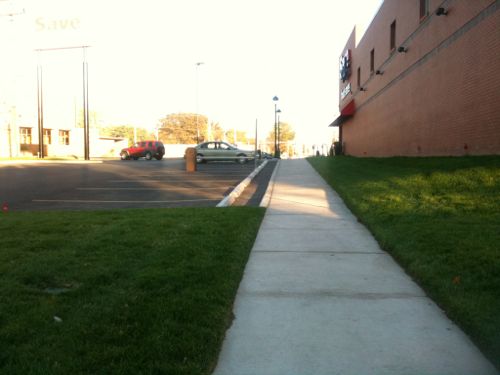
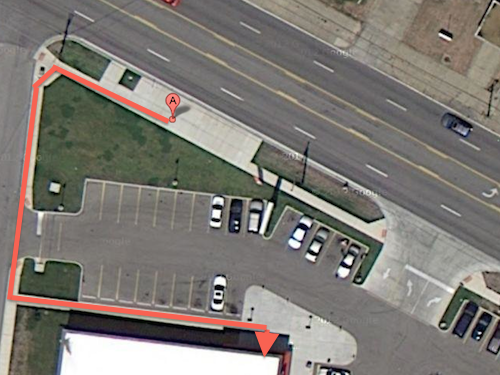
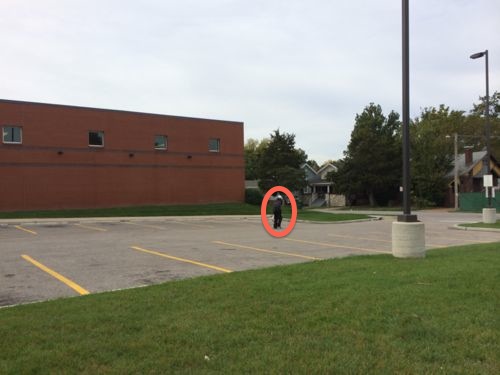
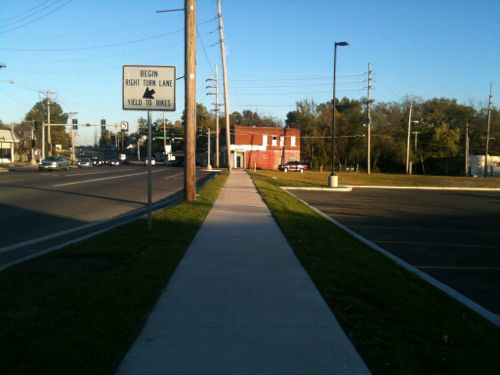
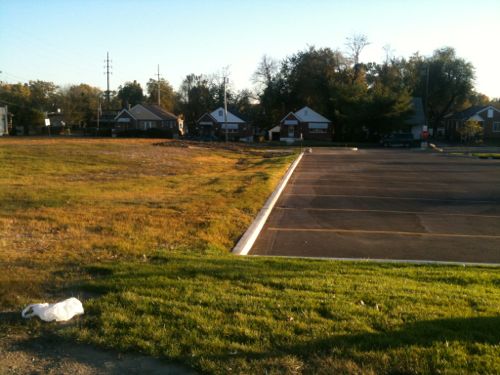
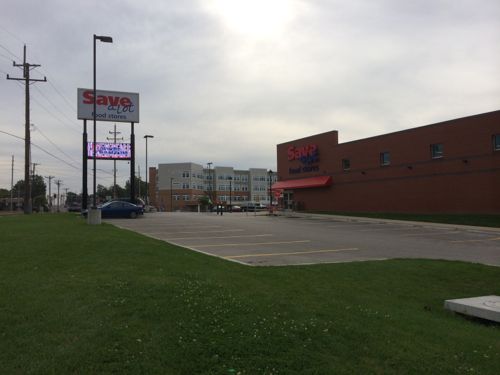
The new development includes a bank and senior apartments:
Mayor of Pagedale Mary Louise Carter looked on as Chris Krehmeyer, president and CEO of Beyond Housing, and Ron Barnes, Midwest BankCentre (MBC) chairman, recently unveiled the city’s first-ever full-service bank.
“This is a great day for the City of Pagedale,” Mayor Carter said. “This means convenience for our residents because they can now bank right in their own city at a financial institution with a long history of excellent service.” (St. Louis American)
Yes, a local bank branch can be very convenient.
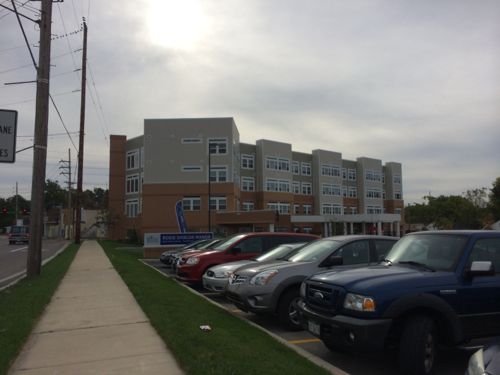
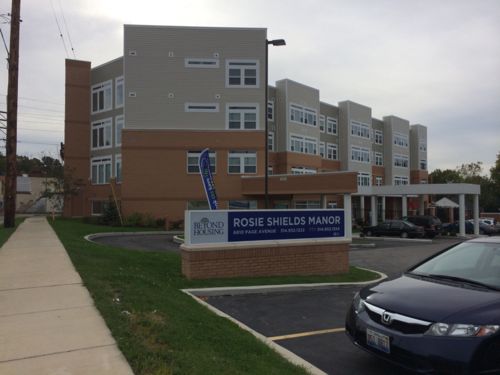
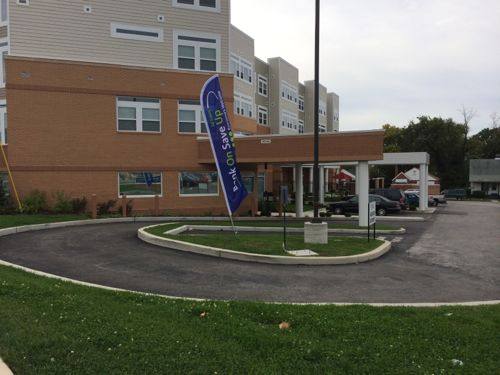
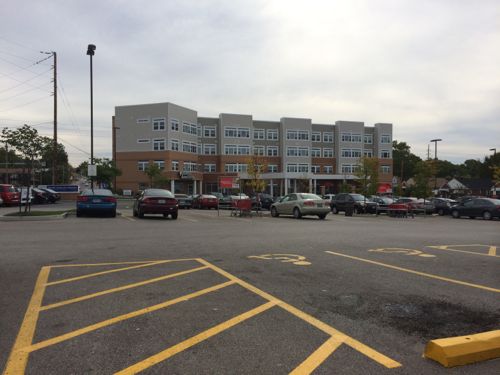
I applaud Beyond Housing for investing in Pagedale, adding needed retail, banking, & housing. But the common “drive everywhere, walk nowhere” viewpoint is expressed in the design. As a result, I’m disappointed.
Numerous buildings were razed allowing them a clean slate. Nobody on the design team asked how a senior got from their apartment to the 1) bus, or 2) grocery store. Maybe they thought all low-income seniors have cars?
— Steve Patterson
Same discussion as yesterday. The site has new, apparently compliant, public sidewalks on all sides of the property, with a bus stop located on the north side. Save-A-Lot provides a safe, accessible, path of travel between the stop and its front door. Beyond Housing’s structure is too new to appear on Google maps, and your photos show only the west and north sides. From what I remember, there is no access on the east side of the structure. What is unknown (to me) and unstated (by you) is what sort of access is available on the south side? Is there a sidewalk between the parking lot and the front of the structure, heading south from the covered entrance, connecting to the public sidewalk on McNamee? If so, there is a legal, accessible path of travel. If not, your headline is correct.
Your headline screams “Beyond Housing Development in Pagedale Ignores Pedestrians, ADA”. One of your photos shows reality: “The customer circled in red was headed west on Page, he took the shortest route.” What you want, but haven’t explicitly said, is for the automobile and its parking to be subservient to pedestrians in every new development. You want arrow-straight, shortest-possible connections between every potential pedestrian destination, even though pedestrians make up only a tiny portion of sales in suburban areas like Pagedale. Even if every resident in Beyond Housing’s building spent their entire monthly check at Save-A-Lot, they would generate far less than 1% of the income Save-A-Lot needs to stay open. Save-A-Lot needs people to drive there way more than they need people to walk, so, yes, they prioritize parking over putting a sidewalk through the middle of the site. And yes, the most direct path between the two front doors crosses (gasp!) six rows of parking and three whole drive aisles.
You pose the question, “Can grandma navigate this using a walker?” The answer is most likely “yes”, and if the answer is “no”, she probably is too feeble to leave her apartment, at all. The shortest, straightest path between the two front doors requires traversing 200′ of smooth concrete, most likely on a sunny morning, when there are few cars in the parking lot. Drivers are used to seeing pedestrians and shopping carts everywhere in parking lots, and the vast majority drive cautiously and defensively. Will there be collisions and accidents? Absolutely, but the vast majority are minor ones. Taking out a half dozen parking spaces and putting in a sidewalk with islands and six curb ramps won’t make things better, either. The constant up and down creates way more of a trip hazard for someone using a walker, and requires more effort for someone using a manual wheelchair, than a flat path between cars. Restriping six parking spaces to create a marked crosswalk might make you happy, but will more likely serve as a place to stash parking carts than creating any meaningful improvement – residents who want to walk to Save-A-Lot will (and do) walk, wherever they want, with or without paint on the pavement.
That leaves my original question – is there a connection between Beyond Housing’s front door and the public sidewalk on McNamee? If not, shame on Beyond Housing and their designers. But if there is a connection, the letter of the law has been met and those few residents who are deathly afraid of vehicles in the parking lot can follow a path that is slightly “safer” (but 4-5 times longer), requiring crossing only one vehicular entrance to get to the grocery store or two vehicular entrances to get to the bus stop. Life is full of risks, but small parking lots, like this one, are pretty low on any list. More pedestrians have been killed or seriously injured around here waiting at bus stops than have been hit in parking lots. Yeah, you have to be careful and watch out for drivers and their blind spots, but so do I and everyone else. I also need to watch out for vehicles when I parallel park and exit my vehicle in urban areas. If you want to make the world safer for pedestrians, and more accessible for people with disabilities, getting sidewalks and curb ramps put in where they’re missing and educating drivers to see pedestrians is far more important than saying that an ADA-compliant connection here “ignores” pedestrians!
There is no access to the senior housing/bank from any of the public sidewalks. No pedestrian connection between the senior housing & grocery store.
One should have read about the housing development first. If they did, they would find out : On site social services provided, free prescription deliveries, and CONTROLLED access with interior and exterior cameras.
They obviously only want their residents to be able to enter the building. Exiting is provided by vehicle…senior bus, EMT, call a ride. etc….all picked up at the door. The sidewalks would be used little, if at all.
So if you live there you aren’t allowed to walk to the bus?
Why would you? All services provided. Volunteer at a low-income senior unit…First they are in poor and unsafe neighborhoods (according to the residents so they won’t go for walks, they don’t have pets to walk either), they have little disposable income to fancy away, and any trips out are almost always in groups. Go spend a day. See how many get out and about by walking.
One word: independence! Seniors also have visitors, some may walk or use public transit. Employees may also use public transit.
Many people like to do their own shopping, even if it’s just for a few favorite things. We once lived near a grocery store that had a retirement home across the (quite narrow) street. We’d regularly encounter quite elderly people putting a few groceries into bags hanging from their walkers, making their slow way to the checkouts.
I think at this point, UrbanReviewSTL just needs to produce a “Steve-Approved” window sticker with your smiling face and a thumbs-up. These can be awarded to existing structures and new developments that go beyond the minimum ADA requirements and display a meaningful recognition and respect for the mobility of both the able and the handicapped. 🙂
Queer Eye for the Real Estate Guy
I use to love reading your blog. A friend and I would often send them back and forth and discuss between ourselves the development of STL. I know a lot has changed since your stroke and I’ve followed along, checking in regularly. Unfortunately, I’ve got to stop. It is no longer a balanced review of all things urban in St. Louis. I agree that walkability and ada accessibility is important, but that is only part you focus on now. It has gotten stale and old. It no longer has the credibility it once had as news source for me regarding St. Louis development. Maybe it is just me and the fact that I’ve been around since nearly the beginning. Maybe a blog titled and focused solely on accessibility would be more appropriate of a venue. I wish you the best of luck.
Thanks for sharing. If you go back through the 9 years of archives you’ll see I wrote about walkability & accessibility long before my stroke. Loughborough Commons, Southtowne Plaza, Gravois Plaza, etc were reviewed before my stroke and critiqued on the same issues. The difference is now I have more credibility gained through personal experience.
I think walkability is a key way to revitalize all of the city and inner ring suburbs.
I have to agree. There are many issues that use to be addressed and now there seems to be just one focus and with the addition of commenters that insult and cut down others with the “I let them hang themselves” just makes this another blog in a world full of blogs. It’s lost it’s focus…no, it’s changed it’s focus and it’s uniqueness.
For 9 years I’ve written about the issues that interest me, the topics I encounter in my daily life. I can’t be all things to all people.
I automatically look at ADA issues as pedestrian issues, but that is probably just me. Still there are very few ADA problems that are not also walkability problems. Steve might be better to approach it from the broader pedestrian view and then dovetail into ADA issues, I don’t know, but I agree his contention that walkability is the key to revitalization of the city. In fact all planning should be predicated to support walkability, everything else would then follow.
In the case of Pagedale, Beyond Housing, knows full well many of the people in Pagedale don’t have autos and walk and use transit to get around. It is likely the fault of the architecture who didn’t understand their client and the neighborhood, and like many architects oblivious to urban design issues. Yet it is the job of the architect to analyze and offer options that a client might find useful and even important for their mission and goals.
In fact if a walkable plan was presented by the architect, Beyond Housing would have been receptive.
Pagedale is a surprisingly walkable community, and actually not a bad place to live. (I have a good friend who lives in Pagedale). If American capitalism was worth a damn the key location of Pagedale connected with transit and major roads would be far more prosperous than it is currently.
In the end the whole conceptualization and use of this site is flawed and it instead is yet another auto orientated project that considers pedestrians as secondary or even nonexistent.
“there are very few ADA problems that are not also walkability problems”
EXACTLY! Why is that so hard for people to understand?
This is why I often focus on the larger walkability issue, everyone can benefit from making St. Louis walkable.
The real key to making the region more walkable is increasing density and fixing the missing links in the public sidewalk network. Yes, the connection between the senior housing and the grocery could have been done differently / “better” here, but, bigger picture, this is way better than putting senior housing further out in the suburbs, a mile or more away from ANY shopping. Along with (instead of?) nitpicking the choices the owners and the design team made on internal site circulation, how about celebrating / congratulating the decision to locate a multi-story, mixed-use structure at the intersection of two bus lines? Why not recognize that there’s a new structure on the corner, instead of a new parking lot? With the clarity of 20/20 hindsight, and absent direct knowledge of why the multitude of design decisions were made, sure, it’s easy to point out problems with any project. How about illustrating what’s been done right, not just what’s been done wrong?
I can’t celebrate the building at the bus lines because they’re unrelated. The people in the building can’t get to the bus lines, the people on the bus lines can’t get into the buildings. This is design failure, not one easily retrofitted either.
Making each new development as pedestrian-friendly as it is motorist-friendly is how we’ll increase density.
I got a chance this morning to go by and see the site in person – you are correct in calling out Beyond Housing, their architect and their civil engineer. Even though there are new sidewalks on the north, east and south sides, the building is oriented facing west, with a drive-thru for the bank on the north end and a loading dock / trash enclosure on the south end. There was no effort to connect the main entrance to any of the public sidewalks with an accessible path of travel, the only pedestrian access is through the parking lot, which is certainly not acceptable under the ADA.
I do disagree that “The people in the building can’t get to the bus lines, the people on the bus lines can’t get into the buildings.” As your one caption notes “The customer circled in red was headed west on Page, he took the shortest route” which, for better or for worse, was through the parking lot. I’d argue that walking 200′ or 300′ through a parking lot to get to the nearest bus stop beats walking a mile or two along a perfect sidewalk to get to the nearest transit line. Beyond Housing gets very mixed grades on this project – The short travel distance is a big positive, the lack of a defined route is a big negative!
You didn’t believe me? Thought there was an entry I neglected to show? I’ve been completely around that development on all sides — both in 2010 and a month ago. I could’ve shown pics from all sides but I didn’t think it was necessary.
When I said people can’t get to the bus line I meant that as an inclusive statement — the able-bodied can avoid cars backing up, walk over curbs & through grass. But not everyone living there or working there can/should have to do so.
Not that I didn’t believe you, I don’t like arguing about or discussing facts that I can’t confirm (as I qualified in my original comment). I’ve driven by the site in the past and was impressed by the urban scale of this building, especially in this non-urban neighborhood, and wanted to see how bad / stupid this “mistake” was with my own eyes. And the real issue here isn’t the residents, it’s the barely-minimum-wage health care workers who staff the facility and likely use transit every day. Either way, there is no excuse for the current situation – I’ll be interested if you ever get a logical one!
St. Louis County is as bad as St. Louis City as you see. (The County would have issued permits). It fails not only at the site planning level, but also at the city planning level. The project does not support street level pedestrian activity in the larger community in any way.
I think we can agree there are likely a million solutions where the pedestrian could be put on equal footing with the auto without jeopardizing either the economics, nor the use of the automobile.
The fact is, this crap is so prevalent that we as a society we accept the mediocre as ok, or even good.
It is absolutely amazing how low American design standards really are.
Like I said, it truly is a mixed bag – a decent, urban-scale, mixed-use building on two bus lines that completely ignores both the ADA and fundamental urban planning principles!
And I have to agree with you on that, I was just pointing out that St. Louis County is as bad as the city for ignoring basic planning principles, which is what we are really talking about.
I do disagree about placing blame completely on Beyond Housing, They certainly have a role here, but the architect deserves the highest criticism in that no client can be expected to understand the nuances of the potential of their site, it is the job of the architect to present those options.
That being said I realize that many, but not all, architects have taken the corporate slash and burn approach to making money and ignore any effort to find design solutions that serve the client and the community at the highest levels so they can crank out whatever sort of design solution that meets minimum requirements in record time.
Not far behind is St. Louis County, who fail to hold the architects accountable nor insure that the community develops in a way that serves the many walking, transit citizens that live in Pagedale.
Ultimately we are at a stage in humanity if it is not yet apparent that we are destroying the earth with global warming, then at least we should recognize, if the evidence around the world is examined, that pedestrian orientated cities have the highest quality of life.
where, in the name of all that is holy, is the walkable part of pagedale? (and don’t say walking from the metrolink station to the flea market, which I do love).
I recently posted about going from Page & Ferguson, where this development is located, nearly a mile to St. Charles Rock Rd & Ferguson. Passed by Pagedale city hall along the way, saw other pedestrians and transit users.
Wump. nothing to do with Metrolink. When Pagedale was built there were originally streetcar lines that went up and down this area on Page and the Rock Rd. Transit is still fairly strong on these routes. If you walk toward Pennsylvania Ave along Page and cross the street and go up say Colby or LeRoy you will experience a short, human scale block, one that ends at Robbins Ave and an elementary school. There are still (fewer now) small scale storefronts especially along Page, but in other locations also. Lot sizes are generally 50 foot or often less. Fifty foot is probably the max lot size for a walkable neighborhood, (preferably smaller). Basically Pagedale is still human scaled, leftover from a transit past.
Up Delmar, right before Hanley Rd, you have Hanley Hills, which is an early subdivision that gave up any pretension of serving the pedestrian. It’s a warren of curved streets that go nowhere, all look the same and it is easy to get lost. Drive back there, it is quite remarkable actually. These are 50 foot lots, which illustrates the importance of the urban configuration needed to support walkability. This is shown by this early, stand alone subdivision. (1949 I believe)
Another little drive worth taking is East of St. Vincent Park on the Rock Rd is a street called Salerno. Turn North and drive to the end. There is a large, magnificent old building. Salerno has heavy foot traffic, especially certain times of day. There are remnants of small scale business operations all around.
So Pagedale has elements of a walkable neighborhood. Transit is available. There are local, small scale stores, neighborhood churches and schools and so on. Not as pedestrian orientated as some other areas in the city to be sure, but it could be improved upon.
Hanley Hills is another story. There is little or nothing that could be done to make it a walkable neighborhood.
“Another little drive worth taking” and “I got a chance this morning to go by and see the site in person”….any one else find these comments funny on a posting about walking?
We live in sprawling region, no one can walk everywhere!
I live in a city, I walk everywhere
wump – so you walk from Dogtown to East St. Louis? St. Charles to Chesterfield? CWE to Webster Groves? Arnold to Alton?! We should be able to walk within our neighborhoods. Most of us “can” walk / hike miles, if we’re physically fit and have both the time and the motivation, but choose not to. I guess you’re just a much better, more fit person than the rest of us . . . . .
I live in the CITY. I dont go to the county, or jeffco, or the east side. So the only relevant palces you listed are the CWE and dogtown. I would say I walk to the CWE about half the time, take metrolink 25% of the time and the bus 25% of the time. I hate dogtown and try to avoid it, but I have a friend there (otherwise I would never go). Its a bad place to get to by transit, so I drive 75% of the time and bus 25% of the time. dogtown is the only place I go in the city where I drive the majority of the time. If I didnt have a friend there I would only go once a year for st fatty’s day, and I would take the bus. I go to webster maybe once or twice a year (only cause of some friends) and I take the bus.
Yes, it is a problem mass transit in St. Louis is so inept that you can hardly take it a mile without jumping through hoops.
so it has no walkable commercial area, got it
No, you don’t “get it” by any stretch of the imagination.
Even worse there are no crosswalks across Page so if you live to the north or come on the bus from the other direction, good luck playing Frogger on Page.